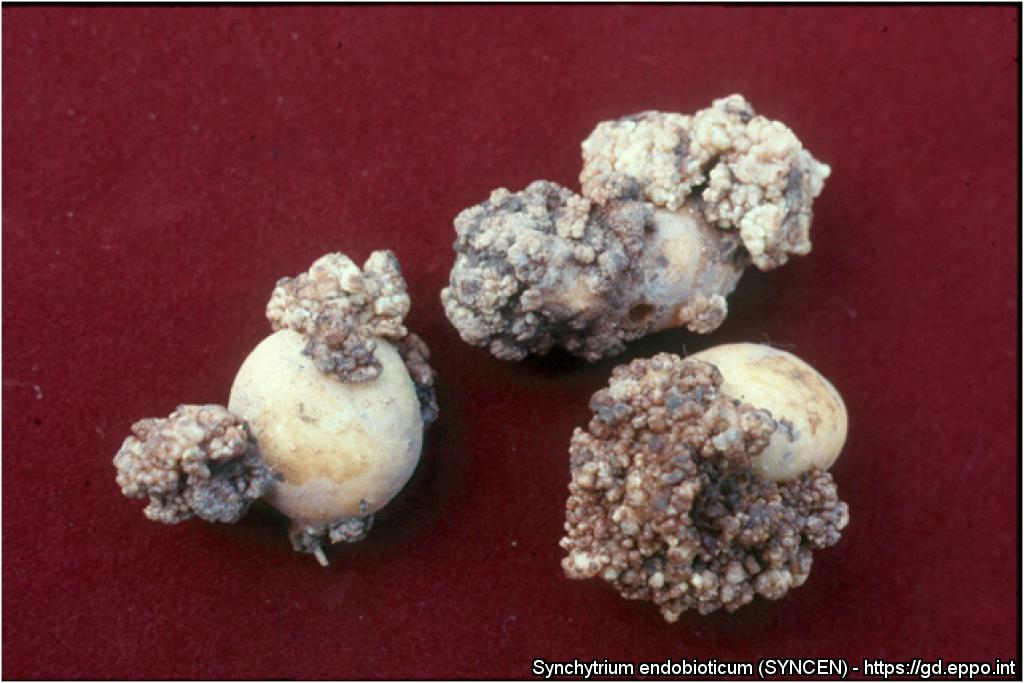Synchytrium endobioticum is a quarantine potato disease in many countries.
Potato is the only cultivated host, but wild Solanum spp. are also infected in Mexico. A number of solanaceous plants, including tomatoes, can be artificially inoculated.
S. endobioticum is an obligate parasite which does not produce hyphae, but produces sporangia containing 200-300 motile zoospores. In the spring, at temperatures above 8°C and given sufficient moisture, the winter sporangia (also called resting spores), in decaying warts in the soil germinate and release uninucleate zoospores. The zoospores possess a single flagellum enabling them to move in soil water and reach the living host. The flagellum is then lost, and the zoospore penetrates the host cell. This becomes greatly enlarged and the enclosed fungus forms a short-lived, quickly reproducing stage, the summer sporangium, from which numerous zoospores are rapidly discharged to reinfect surrounding cells, which again produce summer sporangia .
This cycle may be repeated as long as infection conditions are suitable, so that the host tissue is extensively invaded. The cells around the penetrated cells also swell, and the tissue proliferates, producing a characteristic cauliflower-like appearance.
Under certain conditions of stress, such as water shortage, the zoospores may fuse together in pairs to form a zygote; the host cell in which it forms does not swell but divides. The host cell wall remains closely attached, forming an outer layer to the resistant, thick-walled resting spore. This matures and is released into the soil from rotting warts. Resting spores can remain viable for at least 30 years and can be found in the soil at depths of up to 50 cm (Laidlaw, 1985). The disease can be spread in infected seed tubers which may have incipient warts that pass undetected, or in infested soil attached to tubers. The resting spores resist digestion by animals and can thus be spread in faeces.
Many pathotypes of the fungus exist, defined by their virulence on differential potato cultivars . An overview of the worldwide distribution of pathotypes was given by Baayen et al. (2006). Pathotype 1(D1) is the most common in the EPPO region and, in addition, the only pathotype occurring in most countries. Other pathotypes, now numbered up to 39(P1) (occur mainly in the rainy mountainous areas of Central and Eastern Europe (Alps, Carpathians), for example in the Czech Republic and Germany , but a new pathotype, coded 38(Nevsehir), has also been found in Turkey .
There are no effective plant protection products available for the treatment of tubers. As recommended by EPPO in a national regulatory control system , all tubers and haulms of potatoes that were growing on an infected plot should be ‘treated’ so as to destroy S. endobioticum (e.g. by steaming the tubers and incinerating plant debris, burying and treating with slaked lime) or processed under safe conditions. In scheduled plots it should be prohibited to grow potatoes or to grow (or place in the soil) any plant for planting. Only officially specified resistant potato cultivars are allowed to be planted in a buffer zone around infested land (e.g. as also required in the EU with Council Directive 69/464/EEC.
Wart resistance remains an important element to be considered in potato breeding programmes. Three methods are recommended for testing of wart resistance, these are all laboratory assays: Glynne-Lemmerzahl method, SASA testing method (modified Glynne-Lemmerzahl) and Spieckermann method.
S. endobioticum is of quarantine significance for all the regional plant protection organizations which have established quarantine lists. EFSA suggests that climate would be suitable for its establishment wherever potato is grown in the EU . Though present in many countries, it has a very restricted distribution within them, which justifies its quarantine status. S. endobioticum resting spores persist so long in soil that it has not been possible to evaluate any differences in survival potential under differing soil and climatic conditions and in the presence of other plants.
Photo: EPPO (2024) EPPO Global Database. https://gd.eppo.int
Reference:EPPO (2024) Synchytrium endobioticum. EPPO datasheets on pests recommended for regulation. https://gd.eppo.int (accessed 2024-07-30)

